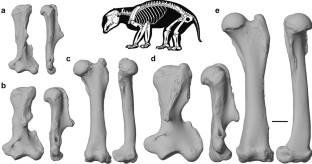Journal of Mammalian Evolution ( IF 1.9 ) Pub Date : 2022-12-23 , DOI: 10.1007/s10914-022-09640-6 Hazel L. Richards , Douglass S. Rovinsky , Justin W. Adams , Alistair R. Evans

|
The relationship between ecology and morphology of the limbs in living placental mammals is well established and has been used to infer aspects of palaeobiology for many extinct species. However, few studies have applied these principles to extinct marsupials. Palorchestids are a poorly understood extinct family of megafaunal marsupials of particular interest due to their highly robust and unusual limb morphology. Using a comparative sample of humeri and femora from living mammals potentially analogous to palorchestids, we applied three-dimensional geometric morphometric techniques in a phylogenetic comparative framework. We established that humerus and femur shape in living species showed significant associations with size, phylogeny, and substrate use, and found a weak association between humeral shape and diet. We then examined patterns in morphological disparity, modularity, covariance and morphospace occupation in palorchestids relative to comparative living mammals as well as their closest extinct marsupial relatives. We found palorchestid femora to be unremarkable in shape, while their overall and proximal humeral morphology were strongly divergent from all other mammals sampled. Over their evolutionary history, palorchestid distal humeri increasingly resembled those of mammals adapted for tearing and hook-and-pull digging, while other analyses showed various arboreal-like and fossorial-like affinities in humeral shape. Our findings indicate strong asymmetric selection acting on the fore- and hindlimbs in palorchestids, and their unique combination of shape traits suggests they used their forelimbs in a specialised manner that has no direct equivalence either with their extinct relatives or among other mammals alive today.
中文翻译:

通过分析哺乳动物的肱骨和股骨形状推断有袋动物的古生物学
活着的有胎盘哺乳动物的四肢生态学和形态学之间的关系已经建立,并已被用于推断许多已灭绝物种的古生物学方面。然而,很少有研究将这些原理应用于已灭绝的有袋动物。Palorchestids 是一个鲜为人知的已灭绝的巨型动物有袋动物家族,由于其高度健壮和不寻常的肢体形态而引起特别关注。我们使用可能类似于 palorchestids 的活体哺乳动物的肱骨和股骨的比较样本,在系统发育比较框架中应用了三维几何形态测量技术。我们确定生物物种的肱骨和股骨形状与大小、系统发育和底物使用有显着关联,并发现肱骨形状和饮食之间的关联较弱。然后,我们检查了 palorchestids 相对于现存哺乳动物及其最近的已灭绝有袋动物亲属的形态差异、模块化、协方差和形态空间占用的模式。我们发现 palorchestid 股骨在形状上并不显着,而它们的整体和近端肱骨形态与所有其他哺乳动物样本有很大不同。在它们的进化史中,palorchestid 的远端肱骨越来越像那些适应撕裂和钩拉挖掘的哺乳动物,而其他分析显示肱骨形状具有各种类似树栖和类化石的亲和力。我们的研究结果表明强烈的不对称选择作用于 palorchestids 的前肢和后肢,



























 京公网安备 11010802027423号
京公网安备 11010802027423号